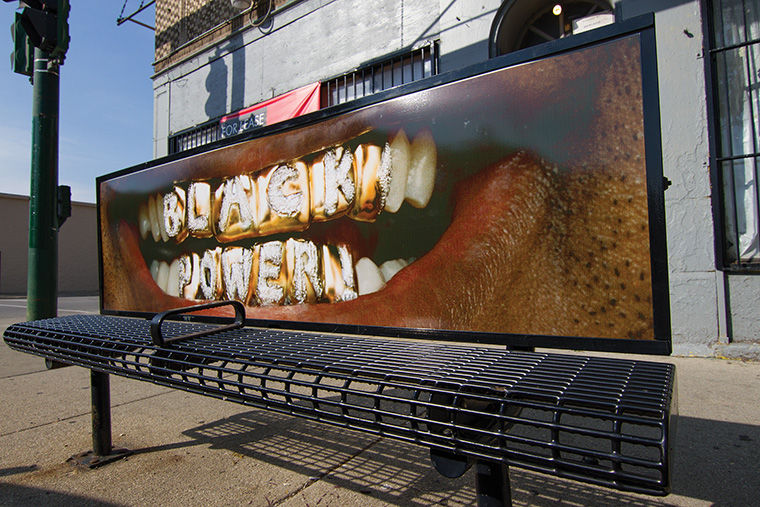Public bench art project receives unwanted graffiti
Public bench art project receives unwanted graffiti
September 22, 2014
RENOWNED CONCEPTUAL ARTIST Hank Willis Thomas’ photography can be seen throughout Wicker Park and Bucktown on six different benches as part of the public art project “Bench Marks,” created by local gallery owner Monique Meloche. However, Thomas’ photographs were recently defaced by graffiti artists in the neighborhood.
Thomas, a New York City native, said he sees artwork get defaced frequently and that it was not a big deal that his was. He said his work is not exempt from vandalism. However, he said he is happy that it has not happened more.
“I learned long ago when you put art into the public you have no idea how people are going to respond,” Thomas said. “There’s been times I put work out into the public and people in African-American communities, who I thought would appreciate the work, were offended by it and that allowed me to really think about the value of the work and put it in a different context which was really important … I’m happy it hasn’t happened more. Maybe people see the images and want them to stay fresh and precious, so for one person to do something is not that big of a deal for me.”
Allison Moore, office assistant at Monique Meloche’s gallery, 2154 W. Division St., said she was told the graffiti looked like a swastika but also appeared to be a gang tag. Moore said the “Bench Marks” series was meant to challenge those benches and spark a discussion about advertising and race and how race-based ads are executed and perceived in that particular area.
“It’s disappointing, but we can’t say we did not expect something to happen to [the photos],” Moore said. “If it’s an actual advertisement, you see stuff tagged all the time. We weren’t anticipating [the graffiti], but it’s also not shocking.”
The work defaced was Thomas’ piece “From can’t see in the morning to can’t see at night,” which showed a photo of a slave picking cotton spliced with an NCAA football player in huddle formation on the field.
“It’s about this eerie kind of history repeating itself between the legacy of sharecropping and the existence of NCAA sports, especially college football,” Thomas said. “It’s the descendants of slaves and share croppers working for free for multi-billion dollar industries, on the same fields that their ancestors used to work on doing very similar heavy physical labor but also with a relationship to cotton andmerchandise.”
Dianna Long, executive director of the Chicago Urban Art Retreat Center, said artists run the risk of having their artwork vandalized when they display pieces in public places because it comes with the territory of being an artist.
“As an artist, to hear about that is really terrible,” Long said. “It’s really distressing. That’s one of the concerns artists have when they create public art.”
Tiffany Wilson, a senior journalism major, said she agrees that artists run the risk of having their work destroyed or defaced but said artists should not have to anticipate it.
“I don’t think it should be expected,” Wilson said. “It is closed-minded and despicable to deface something that somebody has created. I don’t agree with everything that I see, but I don’t destroy it because it’s not mine to destroy.”
Wilson said artists cannot be scared to display or post their artwork because the need for expression is more important than the fear of rejection.
“It’s definitely important to put your art out there,” Wilson said. “It’s important for people to be reminded of beauty as you walk down the street or think those thoughts about where you come from. There’s always going to be some critic, ignorant person or hateful people that are going to do something like vandalism.”
Long said art can be an escape from the stresses and struggles of life and that creativity is therapeutic. Some people do not understand that art can save lives, she said.
“Art is what kept me going,” Long said. “I had a very difficult childhood, and if it had not been for art, I’m not sure what I would have done.”
Wilson said art is important in African-American communities, but even more so to mankind as a whole. She said art is important because it provides history and meaning to culture.
“I think all art is important because it’s a form of expression, it’s a form of communication and it’s important for people to express themselves,” Wilson said. “Art lets us enjoy and celebrate who we are and where we come from.”
Thomas said he thinks it is important for people to find creative ways to express themselves.
“I think for anybody who is not trying to create, they run the risk of being stifled,” Thomas said. “The beauty of fine art,music and writing is that it allows you to think outside the box and all of us can be helped by that.”
Lou Foglia THE CHRONICLE
Hank Thomas’ photo of a person wearing gold fronts that read Black Power is displayed on a bench at 1400 N. Ashland Ave. as part of the series called “Bench Marks.”








